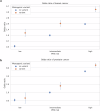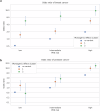Polygenic risk and rare variant gene clustering enhance cancer risk stratification for breast and prostate cancers
- PMID: 39384879
- PMCID: PMC11464688
- DOI: 10.1038/s42003-024-06995-9
Polygenic risk and rare variant gene clustering enhance cancer risk stratification for breast and prostate cancers
Abstract
Polygenic risk score (PRS) and rare monogenic variant screening are valuable tools for predicting cancer risk and identifying individuals at high risk. Integrating both common and rare genetic variants is crucial for accurate risk assessment. However, estimating the impacts of rare variants on cancer and combining them with PRS remains challenging. Here, we analyze 454,711 exome sequencing and 487,409 array UK Biobank samples, focusing on breast and prostate cancers. We introduce an expanded PRS (EPRS) approach, yielding a systematic model for more effective risk stratification. By prioritizing and clustering genes with cancer-specific rare variants based on odds ratios and population-attributable fraction, we refine risk stratification by combining both monogenic and polygenic effects. Individuals in high-PRS groups with rare high-impact gene variants show up to 15- and 22-fold higher risk for breast and prostate cancers, respectively, compared to those in the intermediate-PRS groups without rare variants. Combined risk profiles vary across distinct rare variant clusters within the same PRS group for both cancers. Our EPRS approach enhances risk stratification for breast and prostate cancers, offering important insights for future research and potential applications to other cancer types.
© 2024. The Author(s).
Conflict of interest statement
The authors declare no competing interests.
Figures



References
-
- Soerjomataram, I. & Bray, F. Planning for tomorrow: global cancer incidence and the role of prevention 2020-2070. Nat. Rev. Clin. Oncol.18, 663–672 (2021). - PubMed
-
- Sung, H. et al. Global Cancer Statistics 2020: GLOBOCAN Estimates of Incidence and Mortality Worldwide for 36 Cancers in 185 Countries. CA Cancer J. Clin.71, 209–249 (2021). - PubMed
-
- Britt, K. L., Cuzick, J. & Phillips, K. A. Key steps for effective breast cancer prevention. Nat. Rev. Cancer20, 417–436 (2020). - PubMed
-
- Rebello, R. J. et al. Prostate cancer. Nat. Rev. Dis. Prim.7, 9 (2021). - PubMed
MeSH terms
Grants and funding
LinkOut - more resources
Full Text Sources
Medical
Miscellaneous

